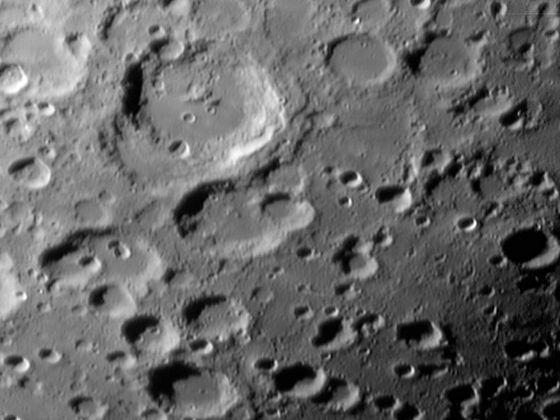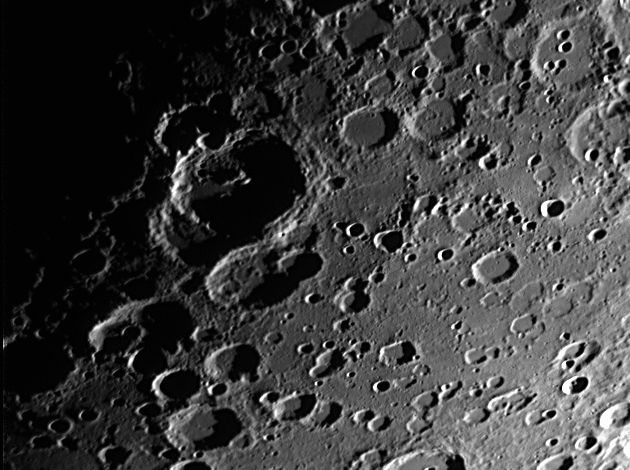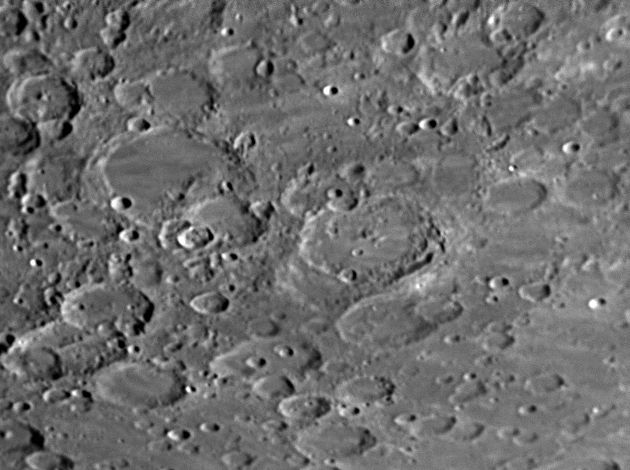

Move your mouse over the picture to see the names of the various features.

Maurolycus and Barocius are ancient craters dating back some 3,900 million years, situated in the rugged highlands
of the southern hemisphere. Maurolycus is 117 Km
in diameter and has very steep walls especially to the east. It has a relatively flat floor with several
small craters and an offset mountain to the north. Barocius is 85 Km in diameter and has walls rising to
3,500 metres, punctured by Barocius B in the north-west.
The picture was taken with a ToUcam attached to my ETX125 with a X2 lens attached on 4th September 2004,
when the Moon was 19.9 days old.
Date and Time: 4th September 2004 04:32 UT
Camera: ToUcam 740K
Telescope: ETX125 with X2 lens
Capture: K3CCDTools. High gamma, 1/50", 20% gain, 324 frames
Processing: Registax. 190 frames stacked. Wavelet 1,2 = 10

This is a wider-angled picture taken at prime focus of my LX200 and shows the area with the light coming from the other direction. It was taken with an IR-pass filter (λ>650nm) on 20th February 2010 when the Moon was 6.1 days old.
This picture abuts that of Boussingault taken the same night. Click on the picture to see a mosaic of the two pictures.
One of the fun things of doing the labelling is finding strangely-named craters. Here we have two: Rabbi Levi is named after Levi ben Gershom, 1288-1344, a French philosopher, mathematician, and astronomer (as far as I know there is no crater on the Moon called either Levi or Gershom); and Gemma Frisius (the parent crater of beyond the top of this picture, but daughters
A, B, and C are present), named after Reinier Jemma Frisius, 1508-1555, a Dutch physician, cartographer, and astronomer.
Date and Time: 20th February 2010 17:44 UT
Camera: DMK 21AF04
Telescope: LX200 with commercial IR-pass filter
Capture: ICCapture. Low gamma (10), 1/19", gain 382, 1473 frames
Processing: Registax. 279 frames stacked. Wavelets 1 = 10, 2 = 5

A similar view to the one above but taken a little later in the lunar day. Maurolucus is at 14° east longitude so the elevation of the Sun was about 50°. This combined with the fact that most of the craters here are rather shallow (Maurolycus is less than 5 Km deep) accounts for the general lack of shadows.
The scale markers are approximately 100 Km north and west.
The picture was taken with a DMK camera attached to my LX200 on 27th December 2017, when the Moon was 8.8 days old.
Lunar Phase: 72.3°
Colongitude: 24.7°
Libration: +6° 56' in latitude, -7° 49' in longitude
Date and Time: 27th December 2017 18:28 UT
Camera: DMK 21AF04
Telescope: LX200 with ADC
Capture: ICCapture. Low gamma (10), 1/876", gain 741, 1800 frames
Processing: Registax6. 23 alignment points, 100 frames stacked per alignment point. Wavelets 1-2 = 10 Home Back to SE Quadrant